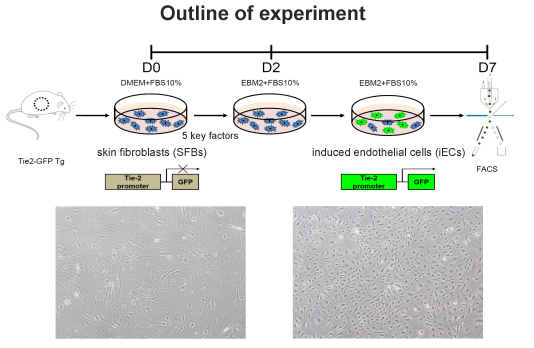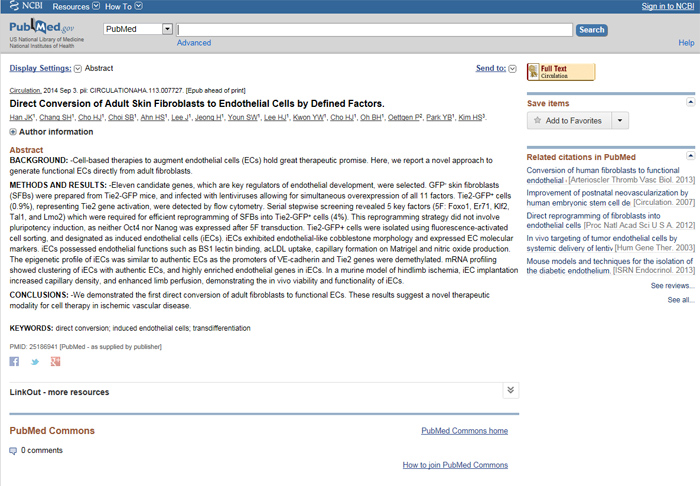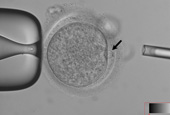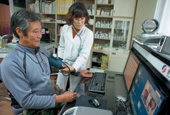Researchers at the Seoul National University (SNU) hospital have succeeded in directly converting adult skin fibroblasts into vascular endothelial cells for the first time.
SNU hospital cardiologists developed a way to transdifferentiate adult skin fibroblasts (SFBs) directly into vascular endothelial cells (iECs) without turning the fibroblasts into induced pluripotent stem cells. Up until now, researchers generally tried to cultivate induced pluripotent stem cells from the fibroblasts and then transdifferentiate the stem cells into vascular endothelial cells. However, this traditional process can cause an outbreak of tumors and cultivating stem cells can be very complicated, making the technology's commercialization difficult.
Ischemic heart diseases, such as angina and cardiac infarctions, are some of the biggest causes of death in the modern world. Currently, coronary artery stents, coronary artery bypass surgery and medications are used as treatment. These methods, however, are far from helping to regenerate healthy blood vessels. SNU's recent discovery is expected to greatly help against such cardiovascular diseases.

Researchers extracted fibroblasts from the skin or tail of a mouse and then infected them with lentiviruses. This allowed for the simultaneous over-expression of five key factors from among the 11 total number of factors. These are required to efficiently reprogram the fibroblasts. The scientists then succeeded in converting the fibroblasts into what are similar to vascular endothelial cells. They then injected the induced vascular endothelial cells back into mice who had their leg blood vessels eliminated. Compared to the control population of mice into which fibroblasts were injected, the mice with the injection of induced vascular endothelial cells showed significant progress in growing new blood vessels and saw improvements in blood circulation.
"This research will bring important changes to the way in which healthy blood vessels are regenerated as it will become possible to create a large number of vascular endothelial cells from our abundant fibroblasts," said a researcher.
The research was supported by the Ministry of Health and Welfare. The results were published online on September 5 in Circulation, a cardiovascular biology journal (www.ncbi.nlm.nih.gov/pubmed/25186941).

By Limb Jae-un
Korea.net Staff Writer
jun2@korea.kr

SNU hospital cardiologists developed a way to transdifferentiate adult skin fibroblasts (SFBs) directly into vascular endothelial cells (iECs) without turning the fibroblasts into induced pluripotent stem cells. Up until now, researchers generally tried to cultivate induced pluripotent stem cells from the fibroblasts and then transdifferentiate the stem cells into vascular endothelial cells. However, this traditional process can cause an outbreak of tumors and cultivating stem cells can be very complicated, making the technology's commercialization difficult.
Ischemic heart diseases, such as angina and cardiac infarctions, are some of the biggest causes of death in the modern world. Currently, coronary artery stents, coronary artery bypass surgery and medications are used as treatment. These methods, however, are far from helping to regenerate healthy blood vessels. SNU's recent discovery is expected to greatly help against such cardiovascular diseases.

Fibroblasts are extracted from the skin or tails of mice and are infected with lentiviruses. This allows the manifestation of five key factors. Then, the cells change and become similar to vascular endothelial cells. This leads to the generation of induced vascular endothelial cells. As a result, new blood vessels are formed and blood circulation is improved. (image courtesy of the Seoul National University hospital)
Researchers extracted fibroblasts from the skin or tail of a mouse and then infected them with lentiviruses. This allowed for the simultaneous over-expression of five key factors from among the 11 total number of factors. These are required to efficiently reprogram the fibroblasts. The scientists then succeeded in converting the fibroblasts into what are similar to vascular endothelial cells. They then injected the induced vascular endothelial cells back into mice who had their leg blood vessels eliminated. Compared to the control population of mice into which fibroblasts were injected, the mice with the injection of induced vascular endothelial cells showed significant progress in growing new blood vessels and saw improvements in blood circulation.
"This research will bring important changes to the way in which healthy blood vessels are regenerated as it will become possible to create a large number of vascular endothelial cells from our abundant fibroblasts," said a researcher.
The research was supported by the Ministry of Health and Welfare. The results were published online on September 5 in Circulation, a cardiovascular biology journal (www.ncbi.nlm.nih.gov/pubmed/25186941).

Research concerning the regeneration of vascular endothelial cells is published online in Circulation on September 5.
By Limb Jae-un
Korea.net Staff Writer
jun2@korea.kr
Related Contents
Most popular
- Grammy-winning producer calls Suga of BTS 'amazing artist'
- 'Universal love, family' themes fuel success of 'King of Kings': director
- Council sets minimum hourly wage in 2026 at KRW 10,320
- Expansion of foreign app system raises tourist convenience
- Nat'l population diversity rose nearly 8% from 2018-22: study





